Casual restaurant chain Noodles & Company (NASDAQ:NDLS) reported results in line with analysts' expectations in Q1 CY2024, with revenue down 3.7% year on year to $121.4 million. The company's outlook for the full year was also close to analysts' estimates with revenue guided to $517.5 million at the midpoint. It made a non-GAAP loss of $0.13 per share, down from its loss of $0.05 per share in the same quarter last year.
Noodles (NDLS) Q1 CY2024 Highlights:
- Revenue: $121.4 million vs analyst estimates of $121.4 million (small miss)
- EPS (non-GAAP): -$0.13 vs analyst estimates of -$0.17
- The company reconfirmed its revenue guidance for the full year of $517.5 million at the midpoint
- Gross Margin (GAAP): 14.8%, down from 15.6% in the same quarter last year
- Same-Store Sales were down 5.4% year on year
- Store Locations: 469 at quarter end, increasing by 8 over the last 12 months
- Market Capitalization: $80.65 million
Offering pasta, mac and cheese, pad thai, and more, Noodles & Company (NASDAQ:NDLS) is a casual restaurant chain that serves all manner of noodles from around the world.
The company was founded in 1995 by Aaron Kennedy in Denver, Colorado and birthed from the simple idea that according to the company, “people love noodles”. The cornerstone of the Noodles & Company offering is not just noodles but fresh, made-to-order dishes.
As mentioned, the menu features noodles from all over the world from Japanese pan noodles to stuffed pastas. In addition to standard menu items, customers can also create their own concoctions by picking noodle types, sauces, and add-ons. Finally, Noodles & Company aims to stay attuned to evolving dietary preferences and offers numerous gluten-free, vegetarian, and low-calorie options.
The core Noodles & Company customer is diverse. Maybe it’s a college student looking for a quick bite or a businessperson seeking a convenient but comforting lunch. Families are also a target customer because everyone can find or create something they like, including kids who can select from the children’s menu. Inside Noodles & Company locations, you’ll find an inviting atmosphere with tables and booths surrounded by neutral colors. However, many customers choose to take out.
Modern Fast Food
Modern fast food is a relatively newer category representing a middle ground between traditional fast food and sit-down restaurants. These establishments feature an expanded menu selection priced above traditional fast food options, often incorporating fresher and cleaner ingredients to serve customers prioritizing quality. These eateries are capitalizing on the perception that your drive-through burger and fries joint is detrimental to your health because of inferior ingredients.
Competitors offering convenient and casual dining options include Potbelly (NASDAQ:PBPB), Chipotle (NYSE:CMG), Sweetgreen (NYSE:SG), and Shake Shack (NYSE:SHAK).Sales Growth
Noodles is a small restaurant chain, which sometimes brings disadvantages compared to larger competitors benefitting from better brand awareness and economies of scale.
As you can see below, the company's annualized revenue growth rate of 1.7% over the last five years was weak , but to its credit, it opened new restaurants and grew sales at existing, established dining locations.
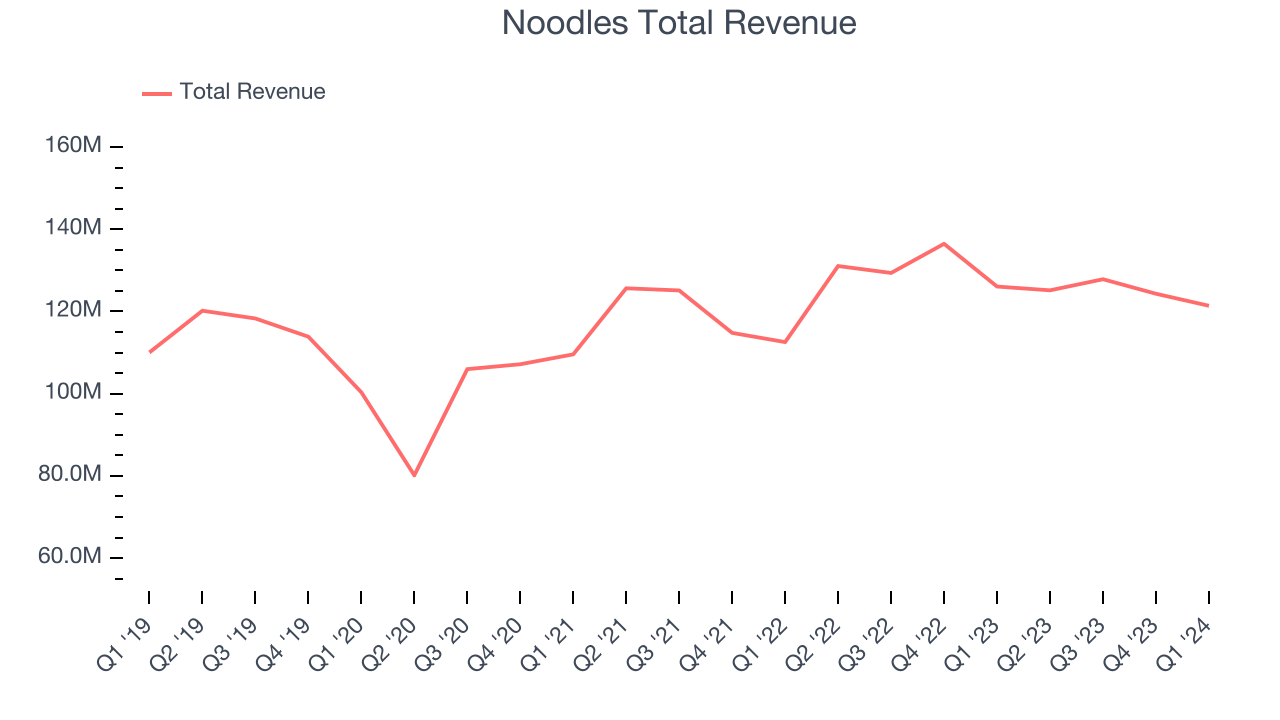
This quarter, Noodles missed Wall Street's estimates and reported a rather uninspiring 3.7% year-on-year revenue decline, generating $121.4 million in revenue.
Same-Store Sales
Same-store sales growth is an important metric that tracks organic growth and demand for a restaurant's established locations.
Noodles's demand within its existing restaurants has barely risen over the last eight quarters. On average, the company's same-store sales growth has been flat.
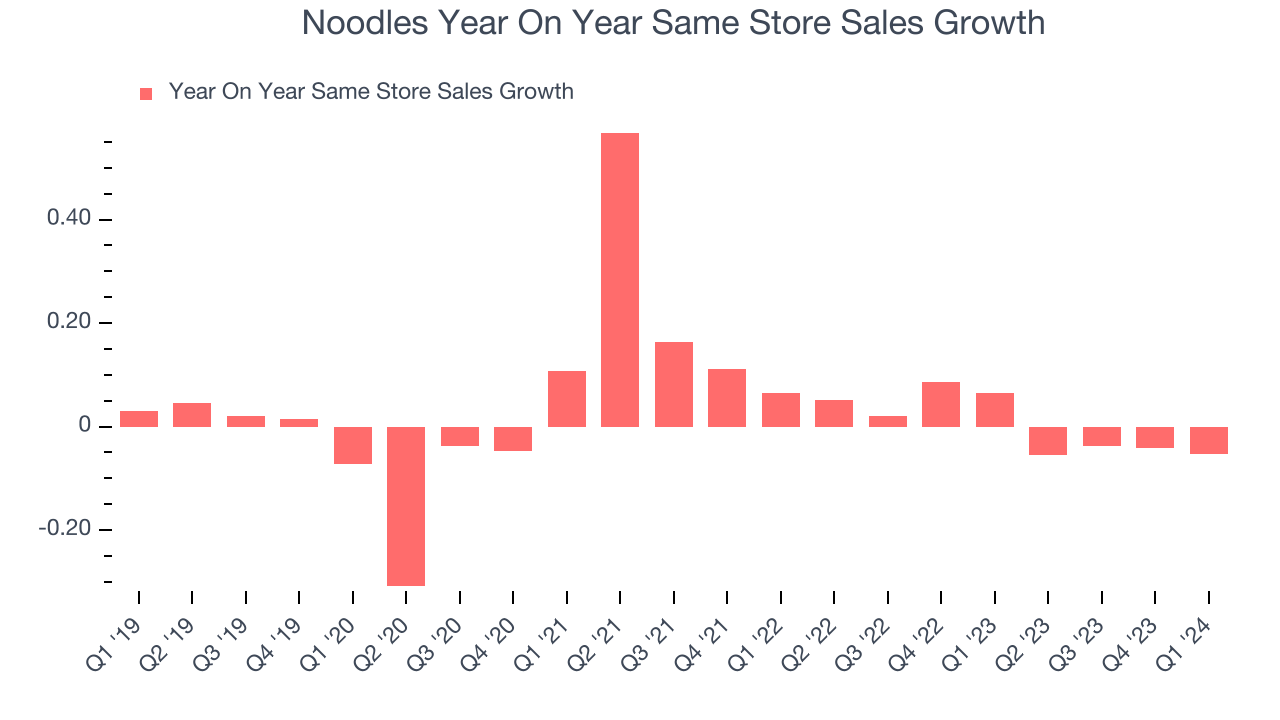
In the latest quarter, Noodles's same-store sales fell 5.4% year on year. This decline was a reversal from the 6.4% year-on-year increase it posted 12 months ago. We'll be keeping a close eye on the company to see if this turns into a longer-term trend.
Number of Stores
A restaurant chain's total number of dining locations often determines how much revenue it can generate.
When a chain like Noodles is opening new restaurants, it usually means it's investing for growth because there's healthy demand for its meals and there are markets where the concept has few or no locations. Noodles's restaurant count increased by 8, or 1.7%, over the last 12 months to 469 locations in the most recently reported quarter.
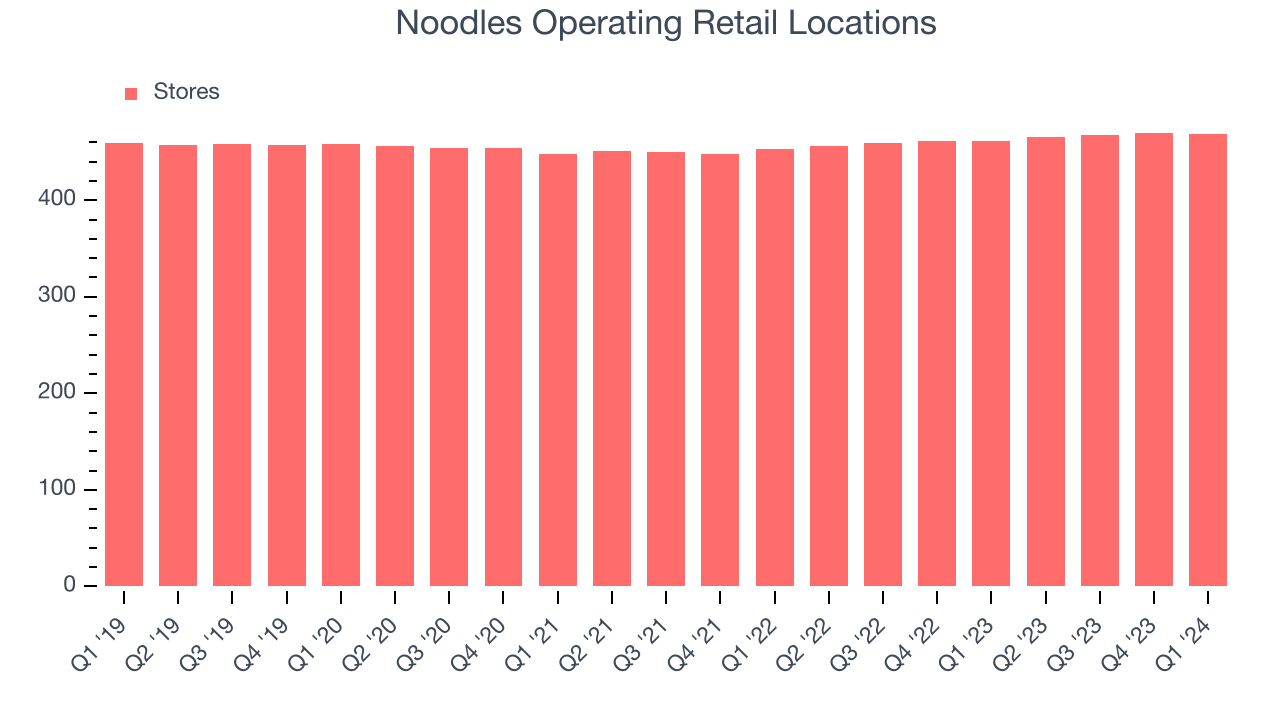
Over the last two years, Noodles has opened new restaurants and averaged 1.9% annual growth in new locations, higher than other restaurant businesses. Comparisons, however, should be taken with a grain of salt as the industry is quite mature. Analyzing a restaurant's location growth is important because expansion means Noodles has more opportunities to feed customers and generate sales.
Gross Margin & Pricing Power
We prefer higher gross margins because they make it easier to generate more operating profits.
Noodles's gross profit margin came in at 14.8% this quarter. in line with the same quarter last year. This means the company makes $0.17 for every $1 in revenue before accounting for its operating expenses.
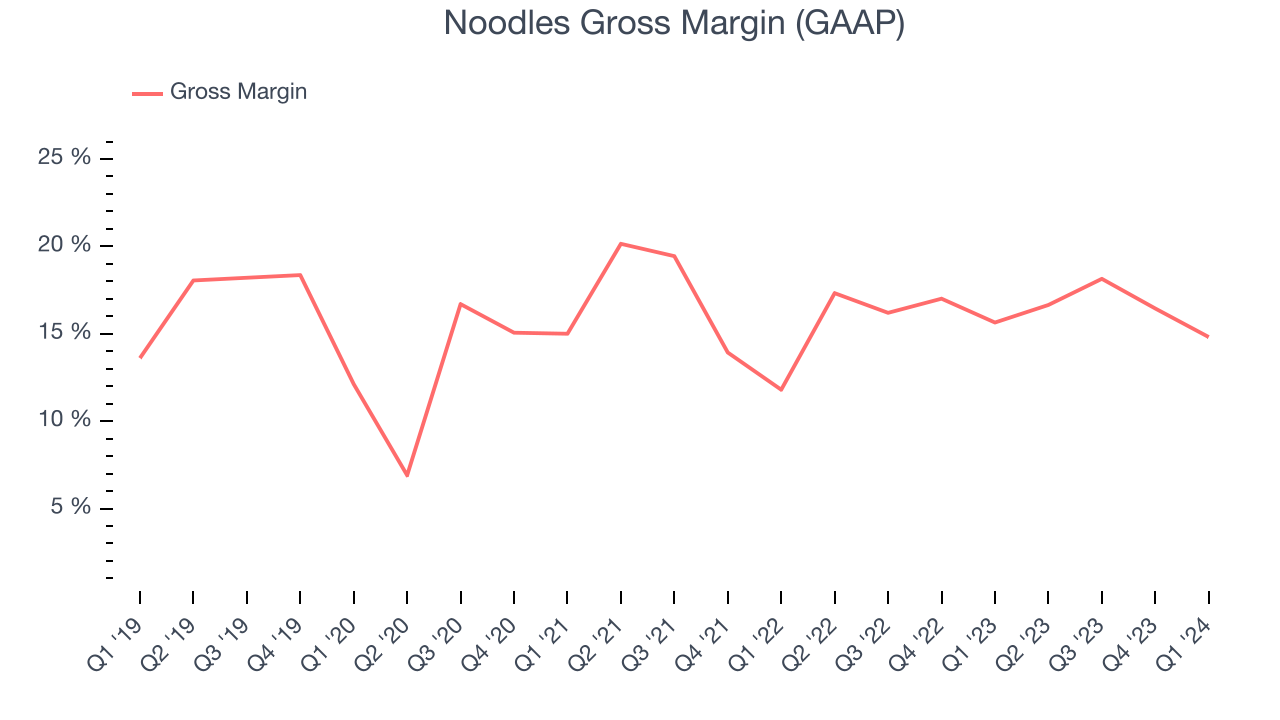
Noodles has poor unit economics for a restaurant company, leaving it with little room for error if things go awry. As you can see above, it's averaged a 16.5% gross margin over the last two years. Its margin has also been consistent over the last year, suggesting it will take a fundamental shift in the business to change meaningfully.
Operating Margin
Operating margin is an important measure of profitability for restaurants as it accounts for all expenses keeping the lights on, including wages, rent, advertising, and other administrative costs.
This quarter, Noodles generated an operating profit margin of negative 3.4%, down 1.6 percentage points year on year. Because Noodles's operating margin decreased more than its gross margin, we can infer the company was less efficient with its expenses or had lower leverage on its fixed costs.
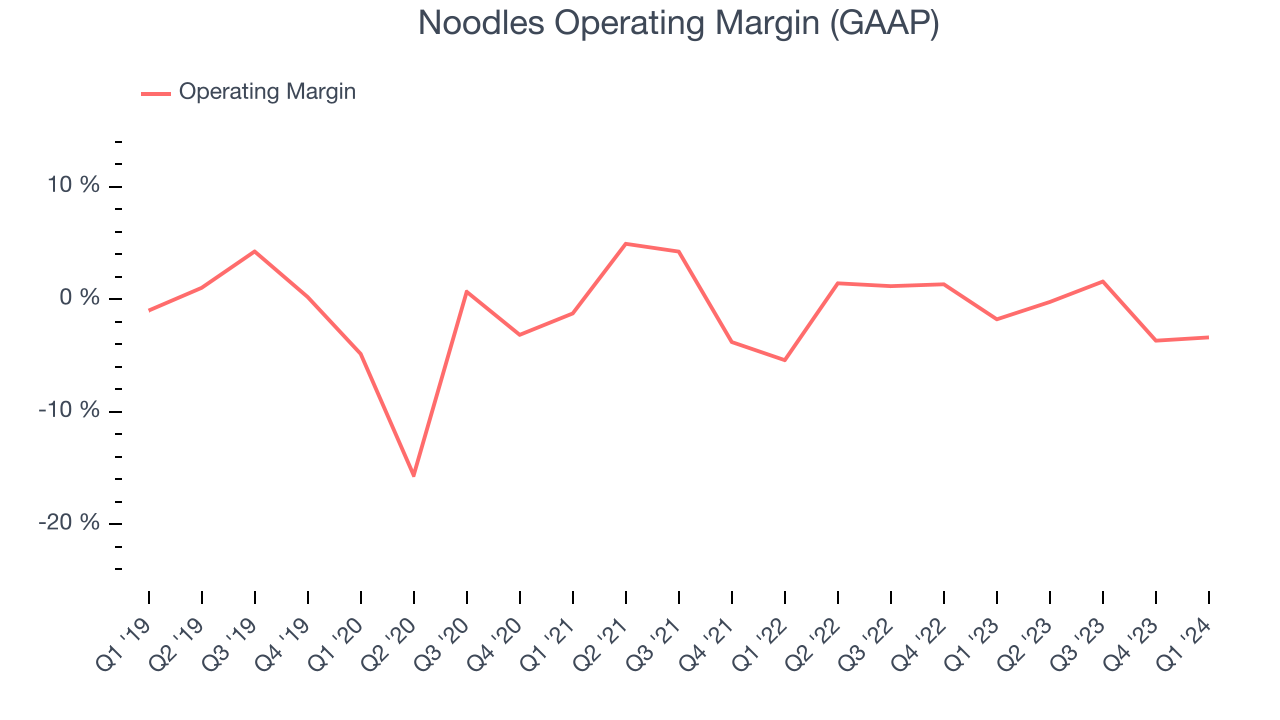 The restaurant business is tough to succeed in because of its unpredictability, whether it be employees not showing up for work, sudden changes in consumer preferences, or the cost of ingredients rising thanks to supply shortages. Unfortunately, Noodles has been a victim of these challenges over the last two years, and its high expenses have contributed to an average operating margin of negative 0.4%. On top of that, Noodles's margin has declined, on average, by 2 percentage points each year. This shows the company is heading in the wrong direction, and investors are likely hoping for better results in the future.
The restaurant business is tough to succeed in because of its unpredictability, whether it be employees not showing up for work, sudden changes in consumer preferences, or the cost of ingredients rising thanks to supply shortages. Unfortunately, Noodles has been a victim of these challenges over the last two years, and its high expenses have contributed to an average operating margin of negative 0.4%. On top of that, Noodles's margin has declined, on average, by 2 percentage points each year. This shows the company is heading in the wrong direction, and investors are likely hoping for better results in the future.EPS
Earnings growth is a critical metric to track, but for long-term shareholders, earnings per share (EPS) is more telling because it accounts for dilution and share repurchases.
In Q1, Noodles reported EPS at negative $0.13, down from negative $0.05 in the same quarter a year ago. This print beat Wall Street's estimates by 25%.
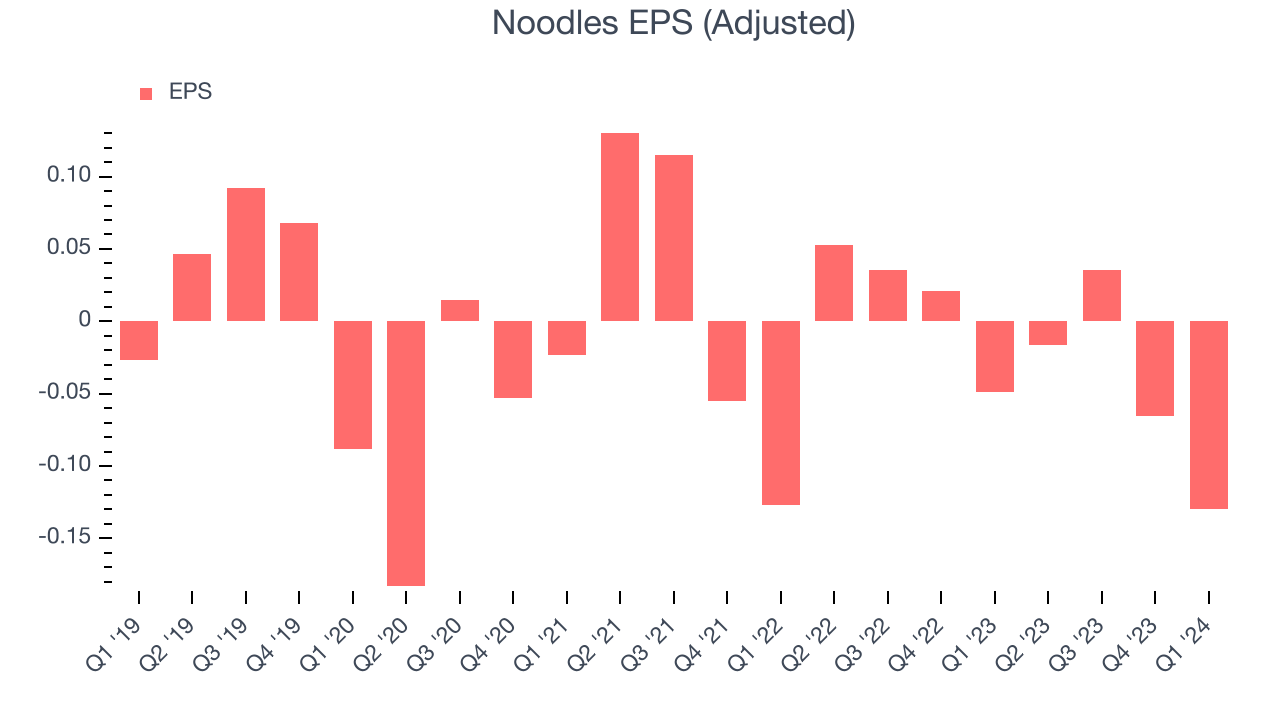
Wall Street expects Noodles to continue performing poorly over the next 12 months, with analysts projecting year-on-year declines in EPS.
Return on Invested Capital (ROIC)
EPS and free cash flow tell us whether a company was profitable while growing revenue. But was it capital-efficient? Enter ROIC, a metric showing how much operating profit a company generates relative to how much money the business raised (debt and equity).
Noodles's five-year average ROIC was negative 6.9%, meaning management lost money while trying to expand the business. Its returns were among the worst in the restaurant sector.
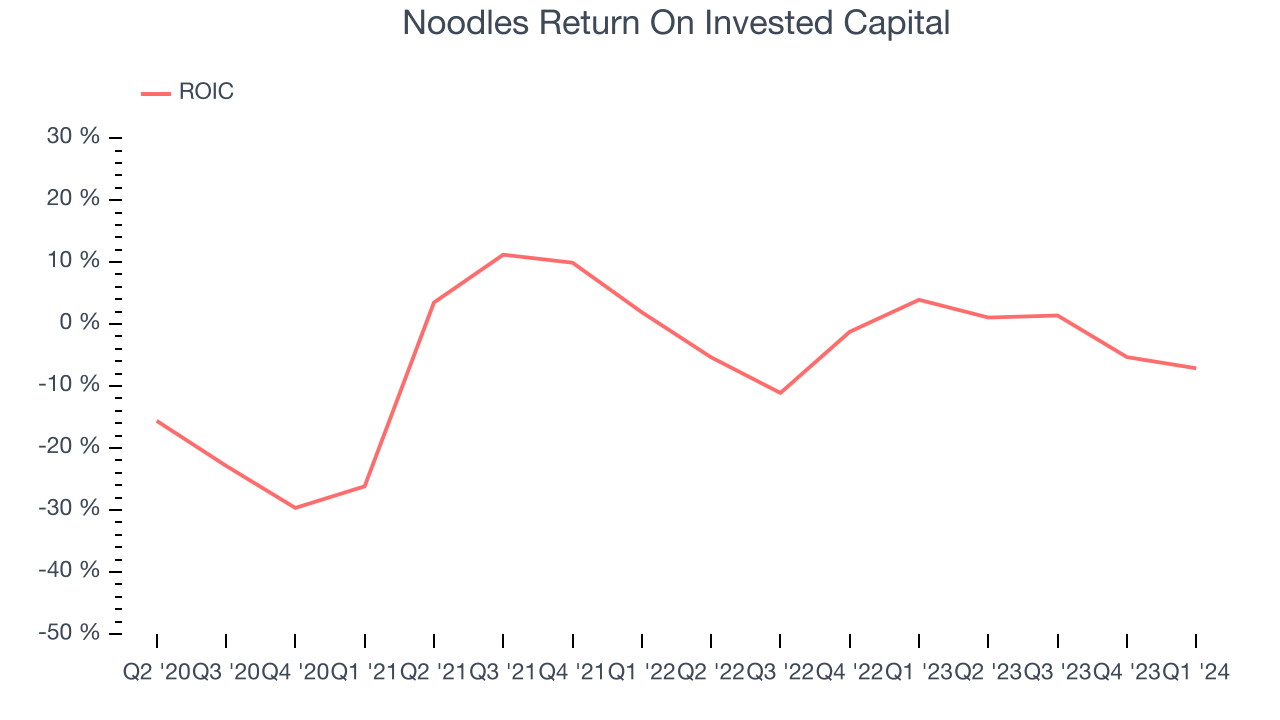
The trend in its ROIC, however, is often what surprises the market and drives the stock price. Over the last few years, Noodles's ROIC averaged 10.5 percentage point increases. This is a good sign, and we hope the company can continue improving.
Balance Sheet Risk
Debt is a tool that can boost company returns but presents risks if used irresponsibly.
Noodles reported $1.3 million of cash and $81.18 million of debt on its balance sheet in the most recent quarter. As investors in high-quality companies, we primarily focus on two things: 1) that a company's debt level isn't too high and 2) that its interest payments are not excessively burdening the business.
With $29.39 million of EBITDA over the last 12 months, we view Noodles's 2.7x net-debt-to-EBITDA ratio as safe. We also see its $1.86 million of annual interest expenses as appropriate. The company's profits give it plenty of breathing room, allowing it to continue investing in new initiatives.
Key Takeaways from Noodles's Q1 Results
It was good to see Noodles beat past analysts' EPS expectations this quarter, though it was still negative. On the other hand, its revenue slightly missed as its same-store sales fell 5.4% year on year. Overall, we think this was a mixed quarter. The stock is down 2.3% after reporting and currently trading at $1.7 per share.
Is Now The Time?
Noodles may have had a mediocre quarter, but investors should also consider its valuation and business qualities when assessing the investment opportunity.
We cheer for all companies serving consumers, but in the case of Noodles, we'll be cheering from the sidelines. First off, its revenue growth has been weak over the last five years. And while its new restaurant openings show it's growing its brand, the downside is its brand caters to a niche market. On top of that, its declining EPS over the last five years makes it hard to trust.
While we've no doubt one can find things to like about Noodles, we think there are better opportunities elsewhere in the market. We don't see many reasons to get involved at the moment.
Wall Street analysts covering the company had a one-year price target of $3.67 per share right before these results (compared to the current share price of $1.70).
To get the best start with StockStory, check out our most recent stock picks, and then sign up to our earnings alerts by adding companies to your watchlist here. We typically have the quarterly earnings results analyzed within seconds of the data being released, and especially for companies reporting pre-market, this often gives investors the chance to react to the results before the market has fully absorbed the information.
